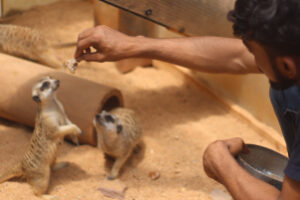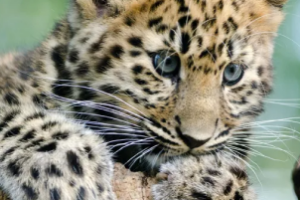
Habitat Viability and Threat Assessment Survey of Indian Soft-Shell Turtle Nilssonia gangetica in Gomti Lake, Central Gujarat, India
A preliminary survey was conducted to determine the conservation importance of Gomti lake situated in Dakor town (Kheda district), Central Gujarat. The lake happens to be one of the last strongholds of an endangered freshwater turtle species— Indian soft-shell turtle (Nilssonia gangetica), and the resident population is now severely threatened due to a complete loss of nesting habitat.
Introduction
The Indian soft-shell turtle (Nilssonia gangetica) is a large freshwater turtle that inhabits the lakes and rivers of India, Pakistan, Nepal, and Bangladesh (Ali et al., 2018; Bhupathy et al., 2000; Lamichhane & Khadka, 2020). In 2018, the species was assessed for the IUCN Red List of Threatened Species for the first time. It is classified as Endangered under A2d+4d criteria (Das et al., 2018). It is also listed as an endangered species in India under Schedule 1 of the Wildlife Protection Act of India, 1972 (WPA, 1972). Gomti Lake is located near the town of Dakor in the Kheda district of Central Gujarat, India. The lake has long been known for its turtle population. Local naturalists have been monitoring the turtles for the past ten years and have now issued an alert due to several threats that could force this local population to extinction.
In December 2012, a rapid survey was conducted to assess habitat viability and threats, as well as identify core issues and viable solutions to conserve these turtles. The most concerning of the threats was the complete loss of nesting ground throughout the lake system. Local naturalists reported no physical sightings of hatchlings or juveniles in the past eight years, as well as no accidental by-catch in fishing nets. Both kinds of sightings have previously been reported. This necessitates an immediate action plan to save the last remaining turtles. With the regular deaths of adults due to both natural and unnatural causes, it is critical to implement a management plan and carry out habitat modifications to ensure the survival of these turtles.
Gomti Lake is located in the Kheda district, near the town of Dakor. Because of its religious significance, Dakor town attracts over 7000,000 pilgrims. The distance between Anand and the nearest city is 35 kilometres.
Background
Gomti Lake is a 2.3 square kilometre natural perennial freshwater body that has served as a water source for both wildlife and humans.
The high fertility of the soil adjacent to the lake has resulted in lake encroachment, replacing water with soil for agricultural use. The lake’s average depth is 10-15 feet in the centre and 3-5 feet along the banks. Because the lake is adjacent to the well-known pilgrim town of Dakor, there are several major highways connecting it to all of the major cities surrounding it. The town’s multiple entry points ensure constant connectivity.
Human settlement
The local human population arrived in the early 1900s. The main occupation of the people is agriculture, but a portion of the population is also involved in some commercial and trading activities both inside and outside of town. According to the 2011 census, the population is 25,658 people (State Census, 2011).
Survey description
On December 12, 2012, a rapid survey was conducted in collaboration with local partners such as the Voluntary Nature Conservancy and the Dakor Nature Club. Throughout the survey, local naturalists were extremely helpful. The survey was conducted in the field for a total of 300 minutes. For efficient transportation in and around the lake, a jeep and a motorised boat were also hired.
Methodology
The lake’s southern bank was surveyed on foot, with biological notes and photographs taken.
A motorised boat was used to survey the lake, looking for evidence of nesting sites on all banks and counting the turtles. A jeep was used to survey the lake’s outskirts. Personal notes and photographs from local naturalists served as the foundation for this study. This allowed for a comparison of the past and the present. This information was compiled over the last ten years.
Findings
The lake appears to be an excellent habitat for aquatic and semi-aquatic plants, fish (carps, anabantids, and so on), and turtles. With all elements present, the large area has the potential to host a very niche ecosystem. It is large enough to support a self-sustaining ecology. Not long ago, the water was potable for human consumption. Several floral and faunal species have been identified as being reliant on this lake for survival.
This is the only large freshwater lake in the Kheda district that qualifies as one of the very few bodies of water where a large carnivorous turtle like the Indian soft-shell turtle can survive. Because of their size, these turtles are unable to travel long distances on land and are thus confined to this lake. Because of changes in land use and a reduction in the number of smaller lakes nearby, these turtles are unable to migrate locally.
Several factors have combined to endanger the previously healthy lake. One obvious factor is direct encroachment on the lake (Fig 2) and conversion to agricultural land. As carrying capacity decreases, this puts constant strain on the existing ecosystem. The second major threat is the daily garbage disposal of pilgrims.
The water level is now artificially maintained after a local town official connected a canal system to a state-wide water connection from the Naramada river. This new venture has introduced invasive floral species such as Eichhornia sp. and Cabomba sp., both of which did not previously exist in the lake.
Around 30 adult Indian soft-shell turtles, several Indian flap-shell turtles, fish, and aquatic flora inhabit the lake. We counted 27 turtles during the time when they surface for air. These were counted from various locations within the lake. To prevent multiple counting, the counts exclude multiple observations from the same location. Since this species is territorial, head counts from various locations provide a reasonable estimation of the current population. According to local naturalists, the annual death rate is roughly eight turtles. Due to their size, floating dead turtles are more visible. The collected turtles are then reported to the forest department and disposed.
The Indian soft-shell turtle is a more specialised species that requires specific environmental conditions because it can only survive in large lakes or rivers. Destruction and degradation of the habitat can result in the extinction of the entire local population. In addition to the previously mentioned threats, no nesting sites were observed. Southern bank has been transformed into “steps” for the use of individuals (resident and visiting pilgrims).
Ironically, the last known nesting site was transformed into a park by the local forest department. The nesting site was completely obstructed in 2005.
Recommendations :
Artificial nesting island
It is recommended that a 70 x 100 m artificial nesting island be constructed in the lake’s northeastern corner.
As a result of the lack of turtle nesting habitat uncovered by the survey, this will need to be completed immediately. This location was chosen because it is secluded from the majority of human activity and is relatively peaceful. This area has a shallow water level throughout the year, making it suitable for the construction of an artificial island. The road accessibility also facilitates the transport of soil and the monitoring of the island by volunteers during breeding seasons. With the cooperation of the local forest department, this particular area can be protected from any direct threats. This island’s development will be crucial and requires immediate consideration.
Education and awareness
A comprehensive education programme focusing on these magnificent turtles and their importance should be implemented in all Dakor town and surrounding villages.
Acknowledgements
I am thankful to Voluntary Nature Conservancy for supporting this survey and organising the logistics. | am thankful to Akanksha Mukherjee and Dipani Sutaria for their assistance and invaluable contributions to the survey. | am thankful to Dakor Nature Club for sharing valuable historical information regarding turtles and public perceptions.
References
1. Ali, W,, Javid, A., Hussain, A., & Bukhari, S. M. (2018). Diversity and conservation of freshwater turtles in Pakistan: A review. Biodiversity, 19(1-2), 62-71. hitps://doi.org/10.1080/14888386.2018.1468820
2. Bhupathy, S., Choundry, B., Hanfee, F., Kaylar, S., Khan, M. H., Platt, S. G., & Rashid, S. (2000). Turtle trade in south Asia: Regional summary (Bangladesh, India and Myanmar). Asian Turtle Trade: Proceedings of a Workshop on Conservation and Trade of Freshwater Turtles and Tortoises in Asia, 2, 101-105.
3. Das, I., Ahmed, M. F., Choudhury, B. C., & Singh, S. (2018). IUCN Red List of Threatened Species: Nilssonia gangetica. IUCN Red List of Threatened Species. https://www.iucnredlist.org/en
4. Lamichhane, S., & Khadka, B. B. (2020). First distribution record of Pangshura flaviventer, Chitra indica, and Aspideretes gangsticus in the major rivers of Chitwan National Park, Nepal. Herpetology Notes, 13, 157-159.
5. Mendiratta, U., Sheel, V., & Singh, S. (2017). Enforcement seizures reveal large-scale illegal trade in India’s tortoises and freshwater turtles. Biological Conservation, 207, 100-105.
6. Pasha, M,, Dutta, R., & Sinha, S. (2009). lllegal trade of fresh water turtles and tortoises in India. Freshwater Turtles and Tortoises of India. ENVIS Bulletin: Wildlife and Protected Areas. Wildlife Institute of India, Dehradun.
7. State Census. (2011). Dakor Municipality City Population Census 2011-2022 | Gujarat. https://www.census2011.co.in/data/town/802581-dakor-gujarat.html
8. WPA. (1972). The Wildlife (Protection) Act. Parliament of India, 74.
About the Author
Soham Mukherjee is a herpetologist and wildlife biologist who specialises in crocodiles and venomous shakes. He has worked as a full-time wildlife rehabilitator with a wide range of taxa, including reptiles, mammals, birds, and arachnids. He has worked on endangered species conservation management projects both in-situ and ex-situ. He is particularly interested in conservation breeding, behaviour and cognition, enrichment in captivity, and human-wildlife interactions. He has extensive experience in snakebite and human-crocodile conflict mitigation, and is a member of the IUCN-SSC Crocodile Specialist Group, Viper Specialist Group, and Snake Specialist Group. He currently works as a specialist consultant for zoos and conservation centres.




